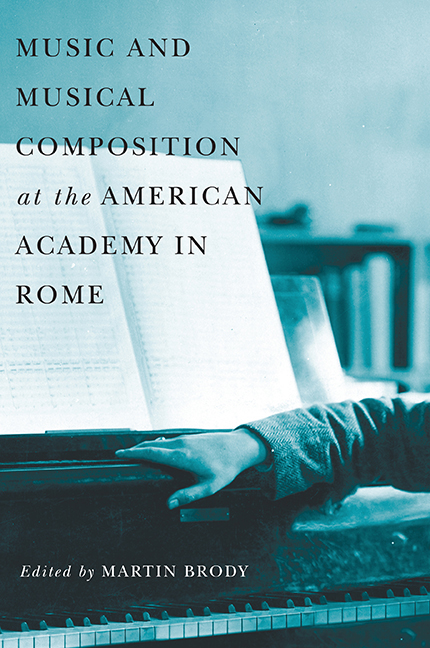Book contents
- Frontmatter
- Contents
- List of Illustrations
- Introduction
- Part One A History of the Rome Prize
- Part Two Origins, Ideology, Patronage
- Part Three Two Case Studies in Internationalism
- Part Four Primary Sources
- Appendix: Composers at the American Academy in Rome, 1921–40
- Selected Bibliography
- List of Contributors
- Index
Introduction
Published online by Cambridge University Press: 25 October 2017
- Frontmatter
- Contents
- List of Illustrations
- Introduction
- Part One A History of the Rome Prize
- Part Two Origins, Ideology, Patronage
- Part Three Two Case Studies in Internationalism
- Part Four Primary Sources
- Appendix: Composers at the American Academy in Rome, 1921–40
- Selected Bibliography
- List of Contributors
- Index
Summary
The United States came late to the game. The French founded a national academy in Rome 110 years before the American Revolution; it took as many years again for the United States to produce a counterpart. Long thereafter, the Americans tended to look over their shoulders at the Académie de France à Rome, if from the high ground of the Janiculum. The French Académie set the stage and established a formidable paradigm for all the ensuing foreign academies that would appear in the Eternal City. The elements were clear: aspiring artists, strong patrons, consecrated antiquities, breathtaking real estate, national glory, cultural hegemony. The composition of the brain trust charged with launching the French enterprise was in itself imposing: Louis XIV's invincible minister of finance, Jean-Baptiste Colbert, joined by the premier peintre du roi, Charles Le Brun, and the celebrated Roman sculptor and architect Gian Lorenzo Bernini.
The institution that they established provided a daunting prehistory for the national academy of a self-conscious and still youthful democratic republic an ocean away. Jacques-Louis David, one of the Académie's most illustrious pensionnaires, offered an especially inspiring model for generations of Americans aiming to solve the equation of high art, patrician patronage, and democratic society. As a Prix de Rome winner in 1774, David had communed with Johann Joachim Winckelmann and demonstrated the virtually mystical benefits of sketching in Rome. In the ensuing years, he steered deftly through the liminal space between empire and republic; and he conducted a lifelong demonstration of the efficacy of neoclassicism as a premise for nationalist art—both as a hero of the first Republic and then in 1804 as court painter to a newly anointed French emperor. This emperor, the first Napoleon, had overseen the Academy's move to the Villa Medici in 1803, a grand building adjacent to the Spanish Steps, located on the magnificent site of the ancient Horti Lucullani.
It would be yet again seventy years before a cadre of elite Beaux-Arts artists and architects would hatch their plan for a corresponding American organization.
- Type
- Chapter
- Information
- Publisher: Boydell & BrewerPrint publication year: 2014



